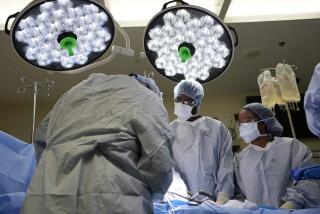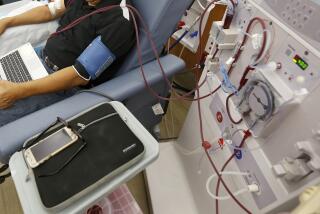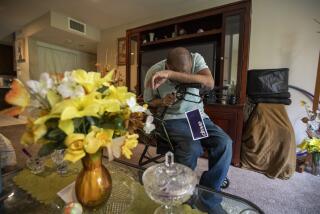Study suggests breakthrough in organ transplants
- Share via
Patients who are lucky enough to get a transplant for a failed organ usually face a lifetime on anti-rejection drugs, which are expensive, dangerous and not always effective.
But in the future, those drugs may not be needed. A new study suggests that patients receiving an organ that’s less than a perfect match can be protected against rejection by a second transplant — this time of the organ donor’s imperfectly matched stem cells.
Though preliminary, the new study is being hailed as a potential game-changer in the field of transplantation, a mystifying development that could offer hope to hundreds of thousands of patients who await or have received donor kidneys and depend on a harsh regimen of daily anti-rejection pills.
GRAPHIC: Donor stem cells in transplants
The small pilot study, reported Wednesday in the journal Science Translational Medicine, describes a novel regimen that combined old-fashioned cancer treatments with 21st century cell therapy to induce five patients’ immune systems to accept donor kidneys as their own despite significant incompatibility.
If the technique proves successful in a larger group of people, future transplant patients may need to take anti-rejection drugs only briefly, and some who rely on them now could discontinue them safely. The recipients of kidneys as well as other organs, including heart, lung, liver and pancreas, might also benefit from access to a wider pool of organs.
The strategy could offer hope, too, for patients receiving bone marrow transplants to treat blood cancers, speeding the process of finding a donor by allowing physicians to use stem cells that today would be rejected as incompatible.
“Few transplant developments in the past half century have been more enticing,” wrote pioneer transplant surgeons James F. Markmann and Tatsuo Kawai of Massachusetts General Hospital, in a commentary accompanying the study. If borne out, they wrote, the findings “may potentially have an enormous, paradigm-shifting impact on solid-organ transplantation.”
In an interview, Markmann said that the greatest benefit of techniques described in the new research would be to greatly improve the lives of transplant patients by freeing them of a lifetime reliance on anti-rejection drugs.
But it might also ease the shortage of transplantable organs somewhat by reducing the number lost to rejection, he said. According to the National Kidney Foundation, 4,573 U.S. patients died in 2008 awaiting a kidney transplant due to a donor shortage.
Markmann added that the study could have “huge potential to open up the pool” of those who could donate stem cell transplants to patients fighting blood cancers. Currently, he said, many of the 6,000 patients yearly who have a stem cell transplant “have to look far and wide for a perfect match.”
The research builds upon a handful of landmark studies that have begun to show how best to trick the human immune system into accepting and defending both a foreign organ and a patient’s own tissues after a transplant, a quest that stretches back decades.
In the study, eight patients with kidney failure received kidneys that were less-than-perfect matches. All came from living donors, and in four cases, the donor was related to the recipient.
The extent to which the organs were incompatible varied from minimal to extreme; one patient’s kidney matched on five out of six “human leukocyte antigens,” or HLAs. The others were compatible on no more than three HLAs.
It’s common for transplant recipients to get organs that are an imperfect match. But holding on to such an organ is a challenge that exacts a serious toll.
To prevent the immune system from mounting an all-out attack on tissue it sees as a foreign invader, patients must follow an arduous drug regimen for the rest of their lives. Without the medications, a transplanted kidney that’s an incomplete match is likely to be rejected, and the patient faces the prospect of dialysis, a repeat transplant or death.
The anti-rejection drugs — typically 15 to 20 pills a day — make patients vulnerable to infection, diabetes, hypertension and cancers: they are so toxic, they often overwhelm transplanted kidneys. They have typically cost as much as $20,000 a year, and remain expensive despite the recent availability of generic versions.
And after all that, many patients reject their transplanted organs anyway.
In this case, for five of the study’s eight participants — two women and three men from 35 to 46 years of age — that’s not how it went. Despite receiving the least compatible kidneys among the study participants, these five were able to discontinue their use of immunosuppressants completely after a year.
They showed no signs of rejecting their organs during a follow-up ranging from six to 20 months after being weaned off anti-rejection drugs
Dr. Abraham Shaked, chief of the University of Pennsylvania’s Department of Transplantation Surgery, who was not involved in the study, said uncertainties persist: It’s not clear, for one thing, whether patients who are enabled to tolerate a mismatched kidney also have weakened “early warning” responses to infections and cancers.
Still, Shaked called the results “absolutely remarkable” and “beyond any expectations.”
The team, led by transplant specialist Dr. Suzanne T. Ildstad, director of the Institute for Cellular Therapeutics at the University of Louisville in Kentucky, first prepared each patient with whole-body irradiation and several days of chemotherapy to suppress an immune response and make space in the blood for a new army of immune cells.
Two days after the kidney transplant operation, patients got an infusion of bioengineered immune cells from the kidney donor.
In almost every way, the second transplantation resembled a bone marrow transplant — a treatment that’s been used to treat blood cancers such as leukemia and lymphoma for decades. But Ildstad’s team defied a cardinal rule: to never transfer an incompatible HLA match from one person to another because it will rarely take.
They got away with it — no patients died and five developed tolerance for their kidney — through tweaking the mix of donor cells transplanted into the patient to induce “chimerism” — a state in which the immune system accepts dissimilar tissue as its own.
Key to this was refining each donor’s stew of cells into an elixir enriched for adult stem cells, the early descendants of stem cells, and a heretofore unrecognized class of cells dubbed “tolerogenic graft-facilitating cells” by the study authors.
In a controversial move to protect their commercial interest in the newly described therapy, the authors declined to detail what those cells were and how they are identified and treated. But they reported that earlier studies in mice revealed that these facilitating cells “potently prevent graft-versus-host disease.”
Transplant recipients were sent home with strict instructions to avoid exposure to sick people and germs and to wash their hands carefully for several days until their new, chimeric immune system stirred to life.
At one month after the transplants, three of the eight patients failed to achieve the state that would allow ongoing acceptance of the mismatched kidney. One eventually rejected the organ and got another; the other two have staved off rejection with continued use of immunosuppressive drugs. The remaining five achieved “complete chimerism” and a year later were weaned off their immunosuppressive drugs without incident.
Dr. David H. Sachs, a transplantation expert at Massachusetts General Hospital and author of a widely hailed recent study on chimerism, called the results “very interesting ... and very different from what others expected.” But he added that they “are not going to be easy to reproduce,” given the authors’ choice to keep the method of cellular preparation a secret.
“We’re really excited about it,” Ildstad said in an interview. She said she hoped next to use the new methods to explore the transplantation of livers and pancreatic islet cells between mismatched donors and recipients.
Ildstad said the success of the study’s five kidney transplant patients has implications beyond the 93,000 Americans currently awaiting a donated kidney. For some of the 12,000 patients awaiting hearts, lungs, livers and other donor organs, the regimen could point the way to improving success rates and reducing reliance on anti-rejection drugs for them as well, she said.
In addition, the authors believe their research could allow the retroactive treatment of transplant patients (mostly those with new kidneys) who are living with imperfectly matched organs — if those donors are still alive and willing to donate stem cells.







